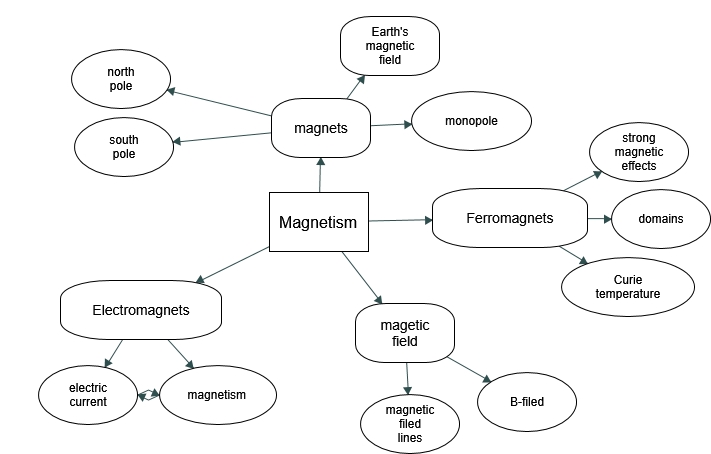24 Main Ideas
Concept Map

Concept Trailer
Key Terms
- Ampere’s law
- the physical law that states that the magnetic field around an electric current is proportional to the current; each segment of current produces a magnetic field like that of a long straight wire, and the total field of any shape current is the vector sum of the fields due to each segment
- B-field
- another term for magnetic field
- Curie temperature
- the temperature above which a ferromagnetic material cannot be magnetized
- direction of magnetic field lines
- the direction that the north end of a compass needle points
- domains
- regions within a material that behave like small bar magnets
- electromagnet
- an object that is temporarily magnetic when an electrical current is passed through it
- electromagnetism
- the use of electrical currents to induce magnetism
- ferromagnetic
- materials, such as iron, cobalt, nickel, and gadolinium, that exhibit strong magnetic effects
- gauss
- G, the unit of the magnetic field strength; 1 G=10–4T
- Lorentz force
- the force on a charge moving in a magnetic field
- magnetic field
- the representation of magnetic forces
- magnetic field lines
- the pictorial representation of the strength and the direction of a magnetic field
- magnetic force
- the force on a charge produced by its motion through a magnetic field; the Lorentz force
- magnetic monopoles
- an isolated magnetic pole; a south pole without a north pole, or vice versa (no magnetic monopole has ever been observed)
- magnetic resonance imaging (MRI)
- a medical imaging technique that uses magnetic fields create detailed images of internal tissues and organs
- magnetized
- to be turned into a magnet; to be induced to be magnetic
- magnetocardiogram (MCG)
- a recording of the heart’s magnetic field as it beats
- magnetoencephalogram (MEG)
- a measurement of the brain’s magnetic field
- Maxwell’s equations
- a set of four equations that describe electromagnetic phenomena
- motor
- loop of wire in a magnetic field; when current is passed through the loops, the magnetic field exerts torque on the loops, which rotates a shaft; electrical energy is converted to mechanical work in the process
- north magnetic pole
- the end or the side of a magnet that is attracted toward Earth’s geographic north pole
- nuclear magnetic resonance (NMR)
- solenoid
- a thin wire wound into a coil that produces a magnetic field when an electric current is passed through it
- south magnetic pole
- the end or the side of a magnet that is attracted toward Earth’s geographic south pole
- tesla
- T, the SI unit of the magnetic field strength;
More terms can be found in the glossary, chapter 22.

